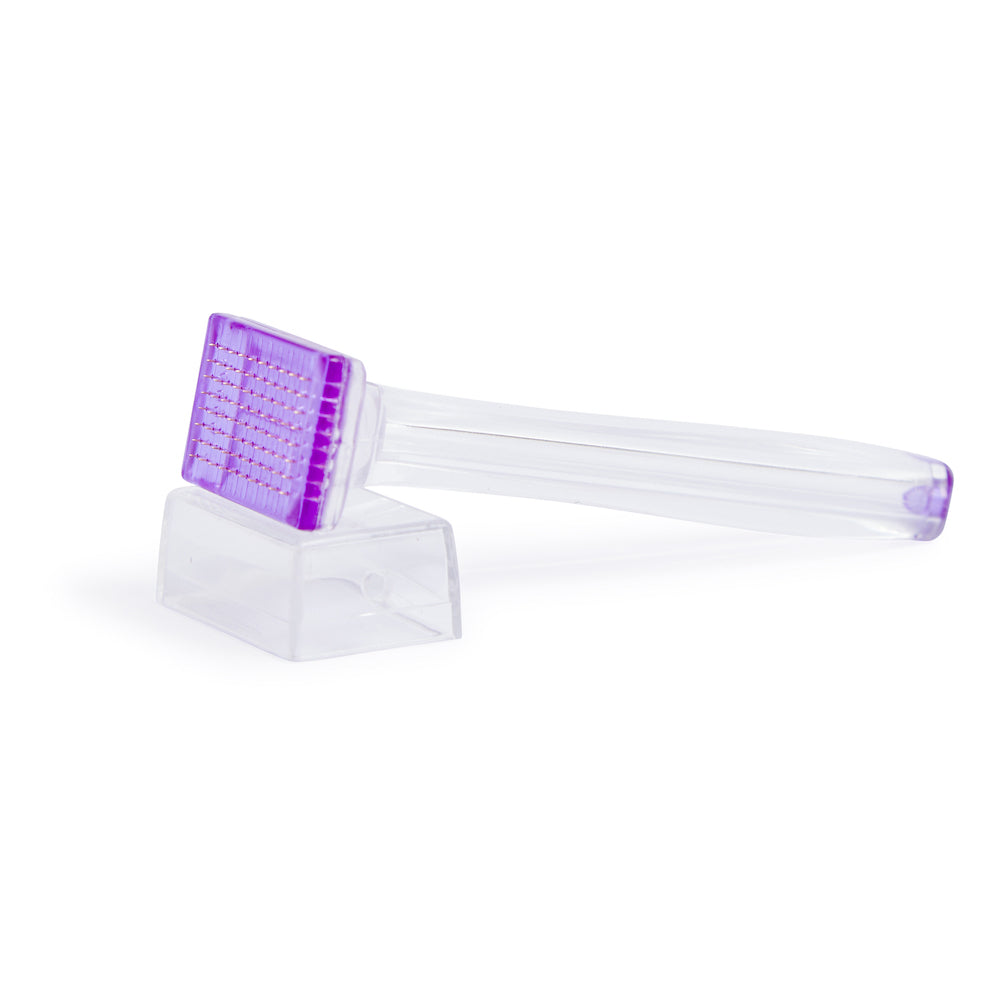
How to use a Dermastamp – The Complete Derma Stamp Guide
What is dermastamp and derma stamping?
They are small cosmetic tools usually containing around 117 microneedles. The microneedles are used to increase the body's own natural collagen production and to increase the transdermal absorption of beneficial products through the skin.
The stamps are largely used to assist hair loss, and scarring and in some cases benefit the signs of aging. This blog will focus on what to look for in a stamp and how to use them for these purposes.
Please note stamps can also be called a derma roller stamp, derma needle stamp, micro derma stamp or derma stamp pen. They should not however be confused with a dermapen which incorporates an electronic insertion technique.
What are the derma stamp benefits?
- They can increase the body’s own natural collagen production by up to 1000%
- They can break down old, misaligned collagen common in scars and replace it with a new smooth layer.
- They can increase the absorption of some products through the skin by up to 10,000 times including powerful cosmetic and hair restoration products.
- They can increase the release of endothelial growth factor which has been shown to promote hair growth and increase follicle and hair size.
- They can benefit platelet-derived growth factor which can assist hair canal formation.
What is the best dermastamp for hair loss?
It is usually best to perform dermastamping with a 1.0mm dermastamp. This is long enough to pass through any remaining hair in the area to ensure an effective treatment. The stamp is preferable to a dermaroller as no hair can become entangled in the roller's axle and pulled out.
When choosing a device make sure the microneedles use a secure interlocking method so there is no risk the microneedles can fall out.
Needle quality is also important. High-quality microneedles will stay sharp for over a year with regular use. One of the leading causes of discomfort during treatments is blunt needles so this is very important.
Discover the White Lotus hair loss derma stamp
How to use derma stamp for hair growth and hair loss
- Make sure any hair in the area is clean.
- Spray the area with the White Lotus Hair Restoration Spray.
- Stamp across the area 10-15 times on each section.
- Cover all affected areas of the scalp.
- Repeat the process once a week.
- Spray the stamp with the White Lotus cleaner after each treatment.
- Use the hair spray daily in between treatments.
Discover the White Lotus Hair Restoration Pack
Derma stamp vs roller for hair growth and hair loss
Generally, stamps are better than derma rollers for assisting hair loss. Unlike dermal rollers, hair does not get tangled in the axle and pulled out. This is very important if the hair is longer than about 5mm in length for both women and men.
When you dermastamp hair, it is very important to go slowly and steadily to ensure the entire scalp is evenly covered. It is much easier to miss a patch than with a roller. Remember to dermastamp hairline areas where hair used to grow as well as existing problem areas.
Should you use a derma stamp for scars and scarring?
Microneedling can reduce the visible signs of scarring by up to 70%. This makes it a very good choice to assist with a variety of scars such as caesarean scars, ice pick scars and to dermastamp acne scars. It targets smaller areas more intensely than a dermaroller.
There have been many scientific studies demonstrating the effectiveness of microneedling for scars. Some have shown that it can improve the appearance of scars by up to 2 grades.
Normal collagen looks like a crisscross lattice structure. In the case of scar tissue, this crisscross pattern is replaced by collagen fibres all aligned in a row. Micro-needling breaks down this misformed collagen and through the wound healing cascade assists the body in creating a completely new matrix of improved collagen.
Derma roller vs derma stamp for acne Scars
If treating large areas of ice pick scars, then the roller is an easier option as it can cover large areas of skin quickly and smoothly. However, to target larger scars caused by acne cysts the stamp can be a good option.
When assisting acne scarring it is important to cover the entire area from a few different angles to make sure that all affected tissue is treated equally.
Be careful if there is still acne in the area. Bursting acne with a microneedling device can increase the risk of scarring. It is better to treat the skin breakouts first if possible or if not make sure only areas that are free of acne are dermastamped.
How to use derma stamp at home for scars – Step by step
Please follow these simple steps to safely use your micro needle device at home -
- Apply the organic green tea oil to the face.
- Remove the stamp from its case.
- Spray it with the Natural microneedling cleaner and allow it to sit for a minute.
- Apply the derma stamper to all areas of the scar including the borders.
- Stamp about 15 times on each area.
- After treatment rinse the stamp under running water and then spray again with the natural microneedling cleaner.
- Store the stamp safely back in its case until next time.
Derma stamp for face and beauty treatments
Microneedle dermastamps can increase the body's own natural collagen production by up to 1,000%. They are very useful for small areas like below the eyes as they can target small spaces that are hard to reach with derma rollers.
When using stamps for this purpose it is often better to obtain smaller stamps that can fit more easily into the niches and grooves of the face.
When performing beauty treatments like this it is important to be very careful with the choice of cosmetic products. The dramatic increase in transdermal absorption means it is important to only use products that have been shown to be safe and effective with microneedling.
Should you use a derma stamp under eyes?
A small stamp can be ideal to target fine lines and wrinkles below the eyes. Microneedling can increase natural collagen induction to improve the appearance of these lines. It can also help reduce sagging and puffiness in the area.
Derma roller vs stamp for stretch marks, cellulite and sagging skin
Generally speaking, as these conditions cover larger areas of skin it is quicker and more efficient to use a roller to increase collagen production and smooth out the skin. If however you only have a stamp available then it can be very effective but slower to use.
In most of these cases, it is best to use a 1.0mm roller rather than a shorter 0.5mm dermastamp or roller. The longer needles allow the microneedling to penetrate through the thicker skin in these areas and pass through any raised misaligned striae tissue.
How to clean derma stamps
Before and after use spray the device with colloidal silver spray or isopropyl alcohol and return it to the safety of its case. Do not soak the microneedles in any solution. Both sprays will kill 99.99% of bacteria but the colloidal silver is normally preferable as any remaining alcohol can dehydrate the skin.
The White Lotus stamp uses a unique interlocking system to attach its microneedles, so glue is not required. Please be aware that some poorer quality microneedling equipment uses glue to attach the needles.
This glue can be dissolved by solutions such as denture cleaner leading the microneedles to fall out. This is why we recommend avoiding soaking the stamp and using cleaning products that are not specifically made for this purpose.
Discover the White Lotus Natural Beauty Tool Cleaner
References
- Henry, S. McAllister, D.V. Allen, M.G. Prausnitz, M.R. (1998). Microfabricated microneedles: a novel approach to transdermal drug delivery. J Pharm Sci. Aug87(8), 922-925.
- Orentreich, D.S. Orentreich, N. (1995). Subcutaneous incision-less (subcision) surgery for the correction of depressed scars and wrinkles. Dermatol Surg. Jun21(6). 543-549
- Yano, K., Brown, L. F. & Detmar, M. (2001). Control of Hair Growth and Follicle Size by VEGF Mediated Angiogenesis JCI. Journal of Clinical Investigations. 107(4), 409-417.
- Takakura, N., Yoshida, H., Kunisada, T., Nishikawa, S. & Nishikawa1, S. (1996). Involvement of Platelet-Derived Growth Factor Receptor-alpha in Hair Canal Formation. Journal of Investigative Dermatology. 107, 770–77
- Schwartz et al, 2006, internet paper. Abstract reflections about COLLAGEN-INDUCTION-THERAPY (CIT) A Hypothesis for the Mechanism of Action of Collagen Induction Therapy (CIT) using Micro-Needles; 1st edition February 2006. 2nd revision January 2007 Horst Lieb
Discover the complete holistic microneedling range




